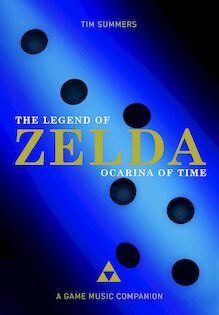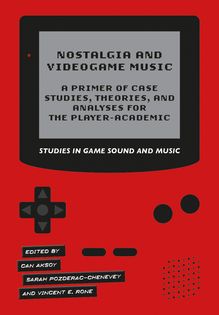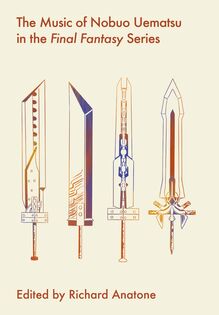-
 Univers
Univers
-
 Ebooks
Ebooks
-
 Livres audio
Livres audio
-
 Presse
Presse
-
 Podcasts
Podcasts
-
 BD
BD
-
 Documents
Documents
-
- Cours
- Révisions
- Ressources pédagogiques
- Sciences de l’éducation
- Manuels scolaires
- Langues
- Travaux de classe
- Annales de BEP
- Etudes supérieures
- Maternelle et primaire
- Fiches de lecture
- Orientation scolaire
- Méthodologie
- Corrigés de devoir
- Annales d’examens et concours
- Annales du bac
- Annales du brevet
- Rapports de stage
La lecture à portée de main
Vous pourrez modifier la taille du texte de cet ouvrage
Découvre YouScribe en t'inscrivant gratuitement
Je m'inscrisDécouvre YouScribe en t'inscrivant gratuitement
Je m'inscrisEn savoir plus
Vous pourrez modifier la taille du texte de cet ouvrage
En savoir plus

Description
Some 22 years after its creation, The Legend of Zelda: Ocarina of Time is still held in high critical regard as one of the finest examples of the video game medium. The same is true of the game’s music, whose superlative reception continues to be evident, whether in the context of the game or in orchestral concerts and recordings of the game’s music.
Given music’s well-established significance for the video game form, it is no coincidence that music is placed at the forefront of this most lauded and loved of games. In Ocarina of Time, music connects and unifies all aspects of the game, from the narrative conceit to the interactive mechanics, from the characters to the virtual worlds, and even into the activity of legions of fans and gamers, who play, replay and reconfigure the music in an enduring cultural site that has Ocarina of Time at its centre. As video game music studies begins to mature into a coherent field, it is now possible to take the theoretical apparatus and critical approaches that have been developed in antecedent scholarship and put these into practice in the context of an extended concrete game example.
The most extensive investigation into the music of a single game yet undertaken, this book serves three important primary purposes: first, it provides a historical-critical account of the music of an important video game text; second, it uses this investigation to explore wider issues in music and media studies (including interactivity, fan cultures, and music and technology); and third, it serves as a model for future in-depth studies of video game music.
Chapter 1. Introduction
Chapter 2. The music of Ocarina of Time in context
Nintendo’s game franchises
The Legend of Zelda
Kondo’s approach to music in The Legend of Zelda
Music on the Nintendo 64
Music in Ocarina of Time
Chapter 3. The ocarina and Link’s musical performances
The ocarina
Why an ocarina?
Playing Link’s ocarina
Beyond the four notes
Learning the ocarina songs
The songs
Plot-advancing and assistance melodies
Warp songs
The Scarecrow’s song and other performances
The Fabulous Five froggish tenors
The Skull Kids
Musical performance in Ocarina of Time
The function of musical performance in games
Chapter 4. Location cues
Part I. Hyrule Field
A familiar tune
Introduction
Day tags
Reflective tags
Battle tags
Music, the player and geography
Part II. Location cues featuring ocarina songs
Epona’s song and Lon Lon Ranch – Associations of ranch life
The Temple of Time and the Song of Time – Cathedral soundscape
Windmill and the Song of Storms – Strange circularity
Saria’s song and the Lost Woods – Jolly repetition and misdirection
Part III. Dungeon cues
Inside the Deku Tree – Organic timbres
Dodongo’s Cavern – Audio textures of metal and stone
Inside Jabu-Jabu’s belly – Fishy rumblings
Forest Temple – Sounds of the forest
Fire Temple – Voices heard and unheard
Ice Cavern – Crystalline chimes
Water Temple – A dungeon on the Danube?
Shadow Temple and the bottom of the well – Voices and drums from the depths
Spirit Temple
Ganon’s Castle
Part IV. Towns
Kokiri Forest – Optimism and ornamentation
Castle Town market – Evoking European traditions
Kakariko Village – A wistful safe haven
Goron City – Sounding the materials of the mountain
Zora’s domain
Gerudo Valley – Hispanic traditions in the desert
Part V. Recurring types of location
Shops – Hyrule’s consumer soundtrack
Sideshow minigames – The fairground connection
Houses – A musical starting point
Potion shops, ghost shops and lakeside laboratory – Little shops of horrors?
Fairy Fountain/start menu – Angelic harps
Music for locations
Chapter 5. Character themes and cutscenes
Part I. Character themes
Zelda’s theme – Lilting lullaby
Ganondorf’s theme – Alarming chords and brooding sequences
Sheik – Atypical warrior’s theme
Kaepora Gaebora (the great wise owl) – Authority and levity
Great Deku Tree – Ancient uncertainty
Koume and Kotake
A noticeable omission
Part II. Other cutscenes
Opening – An unexpected start
Flying – Musical sequences for beating wings
Legends, spirits and goddesses
Rewards and milestones
End credits – Finale ultimo
Ocarina of Time 3D
Music for cutscenes
Chapter 6. Ludic cues
Part I. Combat music
Musical features of combat cues
Implementation in the game
Boss victory cue
Part II. Cues for treasure and challenges
Acquisition cues
Music for puzzles
Music for losing – Game over
Minigames – Frivolous fun
Special sequences
Aestheticizing the Ludic
Chapter 7: Interfaces and sound effects
Earcons for interfaces
Menus and dialogue
Targeting system
Musical sound for interfaces and information
Musicality and magic
Sound and motion
Enemy sound effects
Conclusions
Chapter 8. Ocarina afterlives
Later games
Parallel world – Majora’s mask
Selective franchise continuity
Decontextualizing sound
A multi-valent musical medium
Sujets
Informations
| Publié par | Intellect Books |
| Date de parution | 30 novembre 2020 |
| Nombre de lectures | 5 |
| EAN13 | 9781789382280 |
| Langue | English |
| Poids de l'ouvrage | 3 Mo |
Informations légales : prix de location à la page 0,4250€. Cette information est donnée uniquement à titre indicatif conformément à la législation en vigueur.
Extrait
The Legend of Zelda: Ocarina of Time
Studies in Game Sound and Music
Series editors: Melanie Fritsch, Michiel Kamp, Tim Summers, Mark Sweeney
Intellect’s Studies in Game Sound and Music publishes accessible, detailed books that provide in-depth academic explorations of topics and texts in video game audio. The books present detailed analysis, historical investigation and treatment of conceptual and theoretical issues related to game audio.
The series does not seal game audio into a scholarly suburb but is instead outward-looking: it seeks to engage game audio practitioners and researchers from a range of disciplines, including anthropology, performance studies, computer science, media studies, psychology, sociology and sound studies, as well as musicology.
The Legend of Zelda: Ocarina of Time
A Game Music Companion
Tim Summers
First published in the UK in 2021 by
Intellect, The Mill, Parnall Road, Fishponds, Bristol, BS16 3JG, UK
First published in the USA in 2021 by
Intellect, The University of Chicago Press, 1427 E. 60th Street,
Chicago, IL 60637, USA
Copyright © 2021 Intellect Ltd
All rights reserved. No part of this publication may be reproduced, stored in a retrieval system, or transmitted, in any form or by any means, electronic, mechanical, photocopying, recording, or otherwise, without written permission.
A catalogue record for this book is available from the British Library.
Cover designers: Adam St. Leger-Honeybone and Holly Rose
Copy editor: Newgen KnowledgeWorks
Production manager: Emma Berrill
Typesetting: Newgen KnowledgeWorks
Print ISBN 978-1-78938-227-3
ePDF ISBN 978-1-78938-229-7
ePub ISBN 978-1-78938-228-0
Series: Studies in Game Sound and Music
ISSN: 2633-065
Printed and bound by Short Run, UK.
To find out about all our publications, please visit
www.intellectbooks.com
There you can subscribe to our e-newsletter, browse or download our current catalogue, and buy any titles that are in print.
This is a work of independent, peer-reviewed scholarship and is not an official Nintendo product.
For Mum and Dad.
Contents
List of Figures
List of Tables
Acknowledgements
A Note on Terminology
Introduction
1. The Music of Ocarina of Time in Context
Nintendo’s Game Franchises
Kondo’s Approach to Music in The Legend of Zelda
Music on the Nintendo 64
Music in Ocarina of Time
2. The Ocarina and Link’s Musical Performances
The Ocarina
The Songs
Zelda’s Lullaby – Confounding Musical Signs of Power
The Song of Time – Musically Evoking the Past
Epona’s Song – A Simple Song of Loss
The Sun’s Song – A Fragmentary New Start
Saria’s Song – A Link Between Worlds
The Song of Storms – A Little Bit of History Repeating
Prelude of Light – Subtle Forward Motion
Minuet of Forest – Blending Age and Liveliness
Bolero of Fire – Motion and Passion
The Serenade of Water – Two Characters, Two Perspectives
Nocturne of Shadow – Mystery and Ambiguity
Requiem of Spirit – Religion and Spirits
The Scarecrow’s Song and Other Performances
Musical Performance in Ocarina of Time
The Function of Musical Performance in Games
3. Location Cues
Hyrule Field: A Familiar Tune
Location Cues Featuring Ocarina Songs
Dungeon Cues
Towns
Recurring Types of Location
4. Character Themes and Cutscenes
Character Themes
Other Cutscenes
5. Ludic Cues
Combat Music
Cues for Treasure and Challenges
6. Interfaces and Sound Effects
Earcons for Interfaces
Musicality and Magic
Sound and Motion
Enemy Sound Effects
Conclusions
7. Ocarina Afterlives
Later Games
Decontextualizing Music
A Multivalent Musical Medium
Epilogue
Bibliography
Index
Index of Cues
Figures
1.1: The author’s long-serving Nintendo 64 console with the Ocarina of Time cartridge loaded.
2.1: A Nintendo 64 controller.
2.2: Link playing the ocarina.
2.3: The pitches and controller buttons used when Link plays the ocarina.
2.4: The underside of the Nintendo 64 controller, shown here with the Rumble Pak loaded.
2.5: Link playing the ocarina in the 3DS remake of Ocarina of Time .
2.6: Link learning an ocarina melody.
2.7: The pause menu showing the incomplete collection of melodies.
2.8: The melody of Zelda’s Lullaby, showing the phrases and scale degrees.
2.9: The Triforce symbol on the ground indicates where Link must play Zelda’s Lullaby.
2.10: The Song of Time showing the implied tonality.
2.11: Malon singing at Lon Lon Ranch.
2.12: Epona’s Song, with the three descending gestures marked.
2.13: The Sun’s Song, showing the fragmentary construction of the melody.
2.14: Saria’s Song, heard in the Lost Woods, with the implied IV–I (plagal) movement marked.
2.15: Link befriends a Skull Kid by playing music with him.
2.16: The Song of Storms showing the phrase structure and implied harmony.
2.17: The organ grinder inside the Kakariko Village windmill.
2.18: Prelude of Light, showing the structure and harmonic movement.
2.19: The accompaniment and melody parts of the Minuet of Forest showing the chord structure and regular accompaniment pattern.
2.20: The mechanistic repeated figure of the Bolero of Fire (opening phrase only shown).
2.21: The snare drum accompaniment pattern for the Bolero of Fire.
2.22: The Serenade of Water, showing the harmonic underpinning.
2.23: After Nicholas Gervais, a reduction of the chords concluding the Serenade of Water, showing the smooth stepwise movement of the notes.
2.24: The melody of the Nocturne of Shadow, showing the ‘smoothing’ of the melody as it is repeated and altered.
2.25: Nocturne of Shadow opening phrase, showing the melody and string accompaniment.
2.26: Requiem of Spirit showing the chord structure, suspension and use of a cantus firmus.
2.27: Pierre and Bonooru.
2.28: Link performs for the Fabulous Five Froggish Tenors.
2.29: Link plays a music memorization game with a pair of Skull Kids.
3.1: Hyrule Field, showing Hyrule Castle to the left of the image, and Death Mountain to the right.
3.2: The characteristic accompaniment for Hyrule Field, showing the rhythmic interplay between parts.
3.3: The ‘Legend of Zelda’ theme, showing the location of characteristic figures.
3.4: Brame’s characteristic figures from the ‘Legend of Zelda’ theme.
3.5: Brass melody in Day Variation 2, alluding to the ‘Zelda theme’.
3.6: String melody in Day Variation 6, Battle Variation 1 (and similar melody used in Reflective Variation 4), alluding to the ‘Zelda theme’.
3.7: Each of the reflective tags alludes to the ‘Zelda theme’.
3.8: The accompaniment pattern to Epona’s Song in the location cue for Lon Lon Ranch, showing the influence from country music (excerpt).
3.9: The gothic architecture of the Temple of Time.
3.10: The oom-pah-pah accompaniment to the Song of Storms in the Kakariko Village windmill, showing the harmonic movement (excerpt).
3.11: Accompaniment for the Lost Woods cue (excerpt).
3.12: Inside the Deku Tree, showing the organic textures of the dungeon.
3.13: Pitch set of the Deku Tree dungeon cue.
3.14: Spectrogram of the first pitch of the Deku Tree dungeon cue, lasting 9 seconds.
3.15: Inside Dodongo’s Cavern, showing the stone and lava textures of the dungeon.
3.16: The piscine interior of Jabu-Jabu’s Belly.
3.17: The heartbeat rhythm of Jabu-Jabu’s Belly.
3.18: The string ostinato of Jabu-Jabu’s Belly
3.19: The entry to the wood-themed Forest Temple.
3.20: A selection of the ‘bird call’ fragments of the Forest Temple dungeon cue.
3.21: The Fire Temple, with some of the fiery dangers pictured.
3.22: The Ice Cavern, showing the clear, icy design of the mini-dungeon.
3.23: A spectrogram of one note of the bell chimes in the Ice Cavern cue.
3.24: Chiming chords of the Ice Cavern.
3.25: The Desert Colossus (top, exterior) which houses the Spirit Temple (bottom, interior).
3.26: Approximate transcription of the reeded melody part of the Spirit Temple. The lines above the notes indicate fluctuations in pitch.
3.27: The waveform of the rattle and whistle sound heard in Ganon’s Castle, showing the swelling dynamic profile of the sound.
3.28: A spectrogram of the rattle and whistle sound heard in Ganon’s Castle, showing the rising pitch of the whistle alongside the descending rasping rattle.
3.29: The chords that start Ganondorf’s organ performance.
3.30: An iteration of the rising sequence from Ganon’s Castle (Tower), illustrating the lumbering rhythm, sequence pattern and the dissonance.
3.31: Ganondorf at the organ.
3.32: The bucolic Kokiri Forest.
3.33: The ornamented melody of Kokiri Forest.
3.34: The Castle Town Market, showing the lively and busy location.
3.35: An extract from the first main melody of the Market cue, showing the accentuation of the compound metre by the rhythm in both the percussion and melody.
3.36: The apocalyptic scene in the Market in the future time zone.
3.37: Goron City, showing the prominent wooden, clay and rope textures.
3.38: The interlocking untuned percussion accompaniment of the Goron City cue.
3.39: The aquatic world of Zora’s Domain.
3.40: The clapping ostinato parts of the Gerudo Valley cue.
3.41: An excerpt of the house cue, indicating the interplay between parts.
3.42: Accompaniment rhythm for the Potion Shop cue. The final triplet figure alternates between two different articulations with each repetition, though the rhythm is the same.
3.43: The inside of a Fairy Fountain.
3.44: The rhythmic interplay of the Fairy Fountain harp parts.
3.45: Outline harmony of the Fairy Fountain cue.
4.1: In Zelda’s Theme, the rhythm of Zelda’s Lullaby is complemented by the accompaniment arpeggio, so each part moves while the other is held (excerpt shown).
4.2: Link meets Zelda, both as a youth (top pictures) and as a young adult (lower pictures). In both time zones, Zelda plays the ocarina.
4.3: Ganondorf is revealed behind Link, when they encounter each
-
 Univers
Univers
-
 Ebooks
Ebooks
-
 Livres audio
Livres audio
-
 Presse
Presse
-
 Podcasts
Podcasts
-
 BD
BD
-
 Documents
Documents
-
Jeunesse
-
Littérature
-
Ressources professionnelles
-
Santé et bien-être
-
Savoirs
-
Education
-
Loisirs et hobbies
-
Art, musique et cinéma
-
Actualité et débat de société
-
Jeunesse
-
Littérature
-
Ressources professionnelles
-
Santé et bien-être
-
Savoirs
-
Education
-
Loisirs et hobbies
-
Art, musique et cinéma
-
Actualité et débat de société
-
Actualités
-
Lifestyle
-
Presse jeunesse
-
Presse professionnelle
-
Pratique
-
Presse sportive
-
Presse internationale
-
Culture & Médias
-
Action et Aventures
-
Science-fiction et Fantasy
-
Société
-
Jeunesse
-
Littérature
-
Ressources professionnelles
-
Santé et bien-être
-
Savoirs
-
Education
-
Loisirs et hobbies
-
Art, musique et cinéma
-
Actualité et débat de société
- Cours
- Révisions
- Ressources pédagogiques
- Sciences de l’éducation
- Manuels scolaires
- Langues
- Travaux de classe
- Annales de BEP
- Etudes supérieures
- Maternelle et primaire
- Fiches de lecture
- Orientation scolaire
- Méthodologie
- Corrigés de devoir
- Annales d’examens et concours
- Annales du bac
- Annales du brevet
- Rapports de stage








